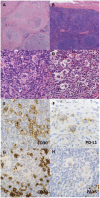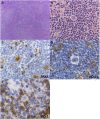Hodgkin Lymphoma: Biology and Differential Diagnostic Problem
- PMID: 35741318
- PMCID: PMC9221773
- DOI: 10.3390/diagnostics12061507
Hodgkin Lymphoma: Biology and Differential Diagnostic Problem
Abstract
Hodgkin lymphomas (HLs) are lymphoid neoplasms that are morphologically defined as being composed of dysplastic cells, namely, Hodgkin and Reed-Sternberg cells, in a reactive inflammatory background. The biological nature of HLs has long been unclear; however, our understanding of HL-related genetics and tumor microenvironment interactions is rapidly expanding. For example, cell surface overexpression of programmed cell death 1 ligand 1 (CD274/PD-L1) is now considered a defining feature of an HL subset, and targeting such immune checkpoint molecules is a promising therapeutic option. Still, HLs comprise multiple disease subtypes, and some HL features may overlap with its morphological mimics, posing challenging diagnostic and therapeutic problems. In this review, we summarize the recent advances in understanding the biology of HLs, and discuss approaches to differentiating HL and its mimics.
Keywords: Hodgkin lymphoma; genetics; tumor microenvironment.
Conflict of interest statement
The authors declare no conflict of interest.
Figures




References
-
- Harris N.L., Jaffe E.S., Stein H., Banks P.M., Chan J.K., Cleary M.L., Delsol G., De Wolf-Peeters C., Falini B., Gatter K.C., et al. A revised European-American classification of lymphoid neoplasms: A proposal from the International Lymphoma Study Group. Blood. 1994;84:1361–1392. doi: 10.1182/blood.V84.5.1361.1361. - DOI - PubMed
-
- Campo E., Jaffe E.S., Cook J.R., Quintanilla-Martinez L., Swerdlow S.H., Anderson K.C., Brousset P., Cerroni L., de Leval L., Dirnhofer S., et al. The International Consensus Classification of Mature Lymphoid Neoplasms: A Report from the Clinical Advisory Committee. Blood. 2022 doi: 10.1182/blood.2022015851. - DOI - PMC - PubMed
-
- Swerdlow S.H. WHO Classification of Tumours of Haematopoietic and Lymphoid Tissues. 4th ed. Volume 2 International Agency for Research on Cancer; Lyon, France: 2017.
Publication types
LinkOut - more resources
Full Text Sources
Research Materials

